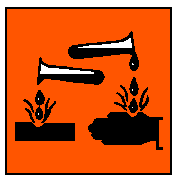International Chemical Safety Cards
| SILVER NITRATE | ICSC: 1116 |
SILVER NITRATE |
 |
| TYPES OF HAZARD/ EXPOSURE |
ACUTE HAZARDS/ SYMPTOMS |
PREVENTION | FIRST AID/ FIRE FIGHTING |
| FIRE | Not combustible but enhances
combustion of other substances. |
NO contact with combustible
substances and incompatible substances such as acetylene, alkalies, halides and other
compounds. |
Water in large amounts. In case
of fire in the surroundings: all extinguishing agents allowed. |
| EXPLOSION | |
|
In case of fire: keep drums,
etc., cool by spraying with water. |
| EXPOSURE | |
STRICT HYGIENE! AVOID EXPOSURE
OF ADOLESCENTS AND CHILDREN! |
|
| INHALATION | Burning sensation. Cough.
Laboured breathing. |
Local exhaust or breathing
protection. |
Fresh air, rest. Refer for
medical attention. |
| SKIN | Redness. Skin burns. Pain. |
Protective gloves. Protective
clothing. |
First rinse with plenty of
water, then remove contaminated clothes and rinse again. Refer for medical attention. |
| EYES | Redness. Pain. Loss of vision.
Severe deep burns. |
Face shield or eye protection in
combination with breathing protection if powder. |
First rinse with plenty of water
for several minutes (remove contact lenses if easily possible), then take to a doctor. |
| INGESTION | Abdominal pain. Burning
sensation. Weakness. |
Do not eat, drink, or smoke
during work. |
Rinse mouth. Do NOT induce
vomiting. Refer for medical attention. |
| SPILLAGE DISPOSAL | STORAGE | PACKAGING & LABELLING | ||
| Sweep spilled substance into
sealable containers. Wash away remainder with plenty of water. Do NOT absorb in saw-dust
or other combustible absorbents. Do NOT let this chemical enter the environment (extra
personal protection: complete protective clothing including self-contained breathing
apparatus). |
Separated from combustible,
organic and incompatible chemicals such as acetylene, alkalies, halides and other
compounds. Cool. Keep in the dark. Keep in a well-ventilated room. |
Unbreakable packaging; put
breakable packaging into closed unbreakable container. C symbol R: 34 S: 2-26 UN Hazard Class: 5.1 UN Packing Group: II |
||
| SEE IMPORTANT INFORMATION ON BACK | ||||
|
||||